If you can accommodate your sensory issues in the privacy of your home, are you less autistic than the Autist who struggles with sensory issues in public?
Well-noted sensory issues for autistic people include the following:
- Loud sounds
- Certain non-loud sounds
- Many people talking in the same room
- Crowds
- Fluorescent lighting
- Changes in temperature
- Certain food textures
- Certain fabrics
- Clothing tags
- Being touched
- The feel of certain textures
This list is far from complete. Though I hate clothing tags and certain non-loud sounds (an example is I replaced the new refrigerator that came with my new home because its hum, which I could hear on the second floor, interfered with my sleep), I have some oddball sensory issues that are driven by my autism.
The sensory issues with clothing tags and humming noises (had to unplug my modem overnight) can be accommodated in a discrete way (e.g., the modem situation was mitigated by moving it to my living room).
Nobody knows I spend as much time as necessary cutting tags down to their nub – even tags that will never touch my skin such as in hats, in slippers and inside wallets. I hate the things.
But other sensory issues of autistic people can interfere with major tasks, creating the illusion that they’re “more autistic” than me.
For example, an aversion to fluorescent lighting (can make them feel ill or get headaches) could prevent an autistic person from conventional shopping and even socializing.
Finding crowds unbearable could eliminate numerous venues. So can the aversive sound of many people talking at the same time (restaurants, social events, weddings, parties).
The accommodations that are needed to avoid these unpleasant stimuli would be noticeable to other people.
Nobody knows the lengths that I’ll take on to eliminate stickers on various merchandise.
I’ll spend what neurotypical people would consider inordinate amounts of time scraping, with an X-acto knife, all stickers off any merchandise.
I’ll cut out the part of fruit where the sticker is, instead of peeling it off. If the steak knife touches the sticker, I’ll use a new knife.
The feel of my fingertip on some grimy sticker or label on an object is, quite frankly, unbearable.
I make a point to avoid any fingertip contact with any sticker, such as the grimy icky one shown below that’s on the tip of a peg where weight plates go at the gym. These stickers indicate the plate amount for the pegs.
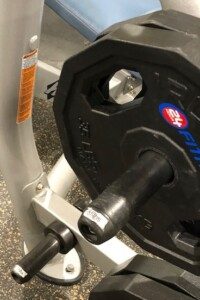
When I place loose carrots in a plastic bag when shopping, I can’t stand the visual of when the carrots are every which-way in the bag.
I correct this by placing all the carrots sideways, aligned. See below.

When carrots end up this way in a bag when I put them in, it’s very visually distressing, and I must immediately correct this.

Ahhh, this is SO much better — nicely aligned!

I can’t help it. Even one carrot out of place is unacceptable.
I hate when Q-tips get out of whack; they must be reasonably straight. See below.
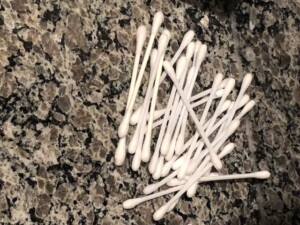
Q-tips on my kitchen sink for when I need them. If they get this way, I won’t tolerate it.
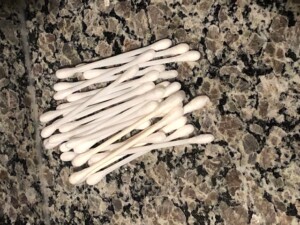
This is much better!

My autistic brain won’t stand for this. Even if I don’t look and just leave it be, the mere knowledge that it’s like this will grate on me.

I will take the time to get them fairly straightened out. If the box fell a second time or somehow got knocked around again, I’d straighten them out again. The slight crookedness of the Q-tips here is barely acceptable. I’d like them to be more aligned, though they don’t have to be perfectly straight.
I hate the sight of tumbleweeds under a car. I’ll simply look away.
When the tennis ball, that hangs from my garage’s ceiling as a cue for how far to pull in, one day got trapped between the rearview mirror and the frame of my car, I couldn’t look at it.
I could easily look at the ball as it normally hangs, but once it got stuck in between the fixtures, the whole dynamic changed.
The instant it happened, I looked away, and I continued looking away as I lifted the ball out. Damn, I can’t even review the image (below) for this article.
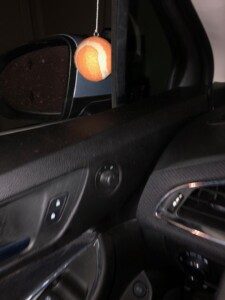
My autism won’t let me look at this.
These sensory issues are easily accommodated without anyone’s knowledge.
Because of this, I may seem “less autistic” to neurotypicals when being compared to an Autist whose sensory issues interfere more with daily living and/or must be accommodated in public for all to see, such as wearing noise-cancelling earphones plus sunglasses inside Walmart.
People at the gym might be surprised I’m autistic because I show no distress over the crowds, can lie smack below a bright light to do dumbbell presses, and I don’t wear noise-cancelling headphones (I wear much less visible earplugs).
My sensory issues might be termed “invisible.” But this doesn’t make me less autistic than someone who needs to get away from the sound of a bunch of people talking at a restaurant.
The image below is one of the WORST as far as intolerance of viewing. As a result, I never, ever put my tube of lip balm in my car’s cupholders. N-e-v-e-r.
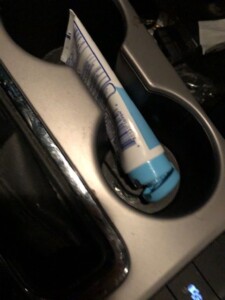
Below is the way it’s supposed to be, but because I’ll never again put it in the cupholder, I’ve freed myself of this visual derangement forever.
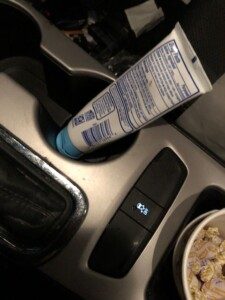
Less Autistic vs. More Autistic
“There are not forms of being ‘more’ or ‘less’ autistic,” says Dr. Jessica Myszak, licensed psychologist, and director of The Help and Healing Center, whose practice is mostly autism assessment for adults.
“Autism is a brain difference that we currently define based on DSM-5 criteria, so you either meet criteria for autism or you do not.
“It can certainly look different in different people, and while there are some common threads that all autistic people have, there are others that are true for some but not others.
“Being hyper- or hypo-sensitive to sensory input is one of the diagnostic criteria that can define autism, though it is not one of the mandatory diagnostic criteria for autism.
“This means that many autistic people do not experience sensory sensitivities, and this does not mean that they are any less autistic.
“Rather than ‘more’ or ‘less or ‘high-functioning’ or ‘low-functioning,’ the current best practice is to describe a person’s autism as being at one of three levels: level 1 requiring the fewest support needs, with level 3 requiring significant support needs.”
And by the way, I can’t stand the sight of gel caps all stuck at the top rim of the bottle. It’s distressing just visualizing this as I write.
They end up flush with the rim when I set the bottle back in the cupboard upside down to denote that I took that particular supplement, as I sometimes don’t take every supplement all at once.
Next day the bottles are right side up; next day upside down.
When the bottles have been upside down overnight, I open them without looking, and instead place my fingers inside the rim to make sure there aren’t gel caps stuck at the top.
This is yet another “hidden” sensory issue – well-hidden from everyone except those reading this.
This private, easily accommodated sensory issue of my autism is as much a sensory issue as an intolerance to store lighting or cotton clothes.
Dr. Jessica Myszak, a psychologist who specializes in autism assessment for both children and adults, is the founder of Autistic Support Network. She sees clients in-person in the Chicago area and over telehealth in 31 states. Learn more about her practice at helpandhealingcenter.com.
 Lorra Garrick has been covering medical and fitness topics for many years, having written thousands of articles for print magazines and websites, including as a ghostwriter. She’s also a former ACE-certified personal trainer. In 2022 she received a diagnosis of Level 1 Autism Spectrum Disorder.
Lorra Garrick has been covering medical and fitness topics for many years, having written thousands of articles for print magazines and websites, including as a ghostwriter. She’s also a former ACE-certified personal trainer. In 2022 she received a diagnosis of Level 1 Autism Spectrum Disorder.
.











































